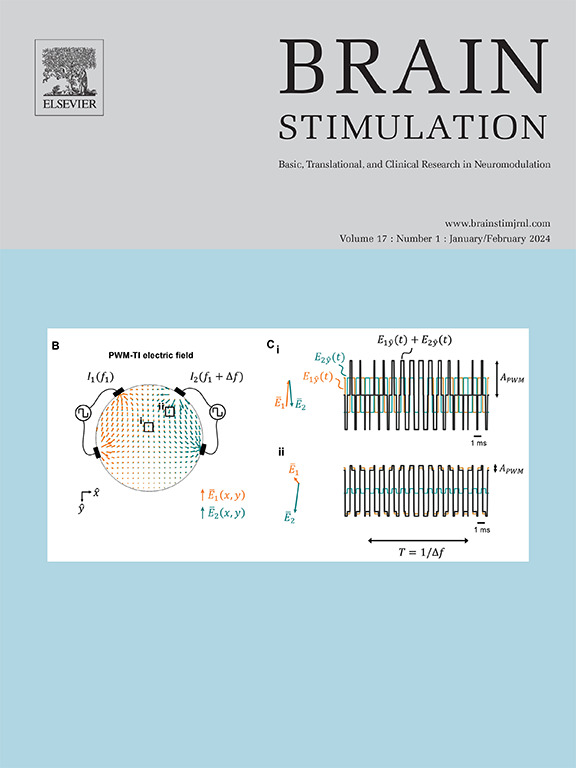Deep brain stimulation-entrained gamma oscillations in chronic home recordings in Parkinson's disease
IF 7.6
1区 医学
Q1 CLINICAL NEUROLOGY
引用次数: 0
Abstract
Background
In Parkinson's disease, invasive brain recordings show that dopaminergic medication can induce narrowband gamma rhythms in the motor cortex and subthalamic nucleus, which co-fluctuate with dyskinesia scores. Deep brain stimulation can entrain these gamma oscillations to a subharmonic stimulation frequency. However, the incidence of entrainment during chronic therapeutic stimulation, its relationship to the basal ganglia stimulation site, and its effect on dyskinesia remain unknown.
Objective
Determine whether the behavioral effects and statistical properties of levodopa-induced gamma oscillations are altered when entrained with deep brain stimulation.
Methods
We used a sensing-enabled deep brain stimulator system, attached to both motor cortex and subthalamic (n = 15) or pallidal (n = 5) leads, to record 993 h of multisite field potentials, with 656 h recorded prior to initiating stimulation. 13 subjects (20 hemispheres) with Parkinson's disease (1/13 female, mean age 59 ± 9 years) streamed data while at home on their usual antiparkinsonian medication. Recordings during stimulation occurred at least five months after initiating stimulation.
Results
Cortical entrained gamma oscillations were detected in 4/5 hemispheres undergoing pallidal stimulation and 12/15 hemispheres undergoing subthalamic stimulation. Entraining levodopa-induced gamma oscillations at either site reduced their prodyskinetic effects. Cortical entrained gamma oscillations had reduced variance in peak frequency, increased spectral power, and higher variance in spectral power than levodopa-induced gamma oscillations.
Conclusion
Stimulation-entrained gamma oscillations are functionally and physiologically distinct from levodopa-induced gamma oscillations that occur in the absence of deep brain stimulation. Understanding the discrepancies between types of gamma oscillations may improve programming protocols.
帕金森病患者慢性家庭记录中深部脑刺激引起的伽马振荡。
背景:在帕金森病中,有创脑记录显示,多巴胺能药物可以诱导运动皮层和丘脑下核的窄带伽马节律,其与运动障碍评分共同波动。深部脑刺激可以将这些伽马振荡带入次谐波刺激频率。然而,在慢性治疗性刺激过程中,其与基底神经节刺激部位的关系及其对运动障碍的影响尚不清楚。目的:探讨左旋多巴诱导的脑深部电刺激是否改变其行为效应和统计特性。方法:我们使用一个具有传感功能的深部脑刺激系统,连接到运动皮层和丘脑下(n=15)或pallidal (n=5)导联,记录993小时的多位点场电位,其中656小时记录在刺激开始前。13名帕金森病患者(20个大脑半球)(1/13为女性,平均年龄59±9岁)在家中接受常规抗帕金森药物治疗时进行数据传输。刺激期间的记录发生在刺激开始后至少5个月。结果:4/5的大脑半球接受苍白质刺激,12/15的大脑半球接受丘脑底质刺激,检测到皮层携带的伽马振荡。在任何一个部位携带左旋多巴诱导的伽马振荡减少了它们的促动力学效应。与左旋多巴诱导的伽马振荡相比,皮质夹带的伽马振荡的峰值频率变化较小,谱功率增加,谱功率变化较大。结论:刺激引起的伽马振荡在功能和生理上不同于左旋多巴引起的在没有深部脑刺激时发生的伽马振荡。了解伽马振荡类型之间的差异可以改进编程协议。
本文章由计算机程序翻译,如有差异,请以英文原文为准。
求助全文
约1分钟内获得全文
求助全文
来源期刊

Brain Stimulation
医学-临床神经学
CiteScore
13.10
自引率
9.10%
发文量
256
审稿时长
72 days
期刊介绍:
Brain Stimulation publishes on the entire field of brain stimulation, including noninvasive and invasive techniques and technologies that alter brain function through the use of electrical, magnetic, radiowave, or focally targeted pharmacologic stimulation.
Brain Stimulation aims to be the premier journal for publication of original research in the field of neuromodulation. The journal includes: a) Original articles; b) Short Communications; c) Invited and original reviews; d) Technology and methodological perspectives (reviews of new devices, description of new methods, etc.); and e) Letters to the Editor. Special issues of the journal will be considered based on scientific merit.
 求助内容:
求助内容: 应助结果提醒方式:
应助结果提醒方式:


